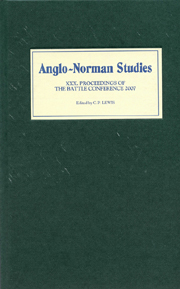Book contents
- Frontmatter
- Contents
- LIST OF ILLUSTRATIONS, MAPS, AND TABLES
- EDITOR'S PREFACE
- ABBREVIATIONS
- The Normans in Welsh History (R. Allen Brown Memorial Lecture)
- William Marshal, Lancelot, and Arthur: Chivalry and Kingship
- Grades of Ordination and Clerical Careers, c. 900–c. 1200
- Evesham J and Evesham L: Two Early Twelfth-Century Manorial Surveys
- Aspects of Church Reform in Wales, c. 1093–c. 1223
- Lay Charters and the Acta of Henry II
- Reinventing Normans as Crusaders? Ralph of Caen's Gesta Tancredi
- Kings, Lords, Charters, and the Political Culture of Twelfth-Century Wales
- Identifying the Warrior on the Pre-Heraldic Battlefield
- St Nicholas the Pilgrim and the City of Trani between Greeks and Normans, c. 1090–c. 1140
- The ‘Resurgence’ of Powys in the Late Eleventh and Early Twelfth Centuries
- Interpreter Families and Anglo-Welsh Relations in the Shropshire-Powys Marches in the Twelfth Century
- A Taste for the Antique? Henry of Blois and the Arts
Aspects of Church Reform in Wales, c. 1093–c. 1223
Published online by Cambridge University Press: 12 September 2012
- Frontmatter
- Contents
- LIST OF ILLUSTRATIONS, MAPS, AND TABLES
- EDITOR'S PREFACE
- ABBREVIATIONS
- The Normans in Welsh History (R. Allen Brown Memorial Lecture)
- William Marshal, Lancelot, and Arthur: Chivalry and Kingship
- Grades of Ordination and Clerical Careers, c. 900–c. 1200
- Evesham J and Evesham L: Two Early Twelfth-Century Manorial Surveys
- Aspects of Church Reform in Wales, c. 1093–c. 1223
- Lay Charters and the Acta of Henry II
- Reinventing Normans as Crusaders? Ralph of Caen's Gesta Tancredi
- Kings, Lords, Charters, and the Political Culture of Twelfth-Century Wales
- Identifying the Warrior on the Pre-Heraldic Battlefield
- St Nicholas the Pilgrim and the City of Trani between Greeks and Normans, c. 1090–c. 1140
- The ‘Resurgence’ of Powys in the Late Eleventh and Early Twelfth Centuries
- Interpreter Families and Anglo-Welsh Relations in the Shropshire-Powys Marches in the Twelfth Century
- A Taste for the Antique? Henry of Blois and the Arts
Summary
In 1093, not far from Brecon, the ‘French who were inhabiting Brycheiniog’ killed the king of Deheubarth. For Sir John Edward Lloyd, the death of this native ruler, Rhys ap Tewdwr, ‘opened the flood-gates of Norman rapacity in South Wales’. In John of Worcester's chronicle, this was the day from which ‘kings ceased to bear rule in Wales’; and a Welsh cleric of the time judged that ‘the kingdom of the Britons was overthrown’.
On the west coast, near Aberystwyth, in the ancient community of St Padarn at Llanbadarn Fawr, the renowned scholar Rhygyfarch ap Sulien composed a poetic lament on the ravages wrought by the Norman invasion. ‘Nothing is of any use to me now’, he wrote, ‘the people and the priest are despised by the word, the heart, and the work of the Normans … Patriotism and the hope of self-government flee; liberty and self-will perish.’
By this time Rhygyfarch – viewed by the annalists as ‘the most learned of the learned men of the Britons’ – was head of an ecclesiastical dynasty that had dominated the Church in south-west Wales for at least two generations. In Planctus – his ‘Lament’ – he set his face against the Normans. Rhygyfarch, best known for his Life of St David, was the eldest son of Bishop Sulien. Twice bishop of St David's (in 1073 and 1080), and twice resigning the see after an incumbency of five years (first in 1078, and again in 1085, dying in 1091), Sulien was himself also offspring of a clerical family.
- Type
- Chapter
- Information
- Anglo-Norman Studies 30Proceedings of the Battle Conference 2007, pp. 85 - 99Publisher: Boydell & BrewerPrint publication year: 2008



